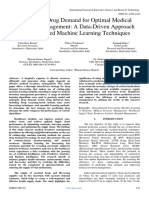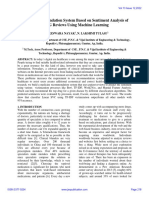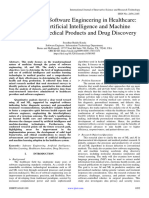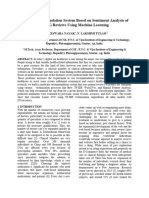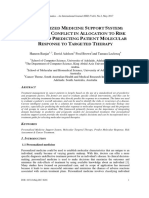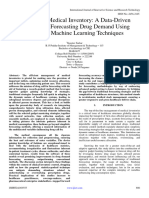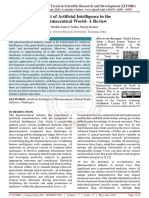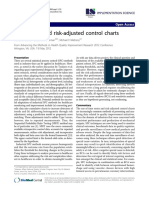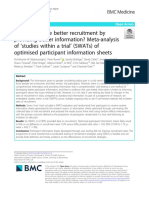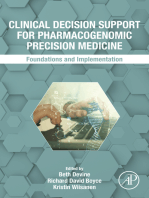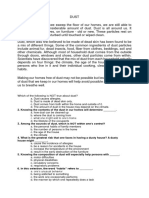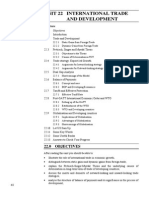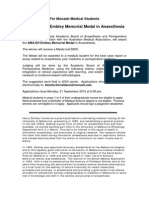Professional Documents
Culture Documents
Drug Dosage Control System Using Reinforcement Learning
Drug Dosage Control System Using Reinforcement Learning
Original Title
Copyright
Available Formats
Share this document
Did you find this document useful?
Is this content inappropriate?
Report this DocumentCopyright:
Available Formats
Drug Dosage Control System Using Reinforcement Learning
Drug Dosage Control System Using Reinforcement Learning
Copyright:
Available Formats
Volume 9, Issue 4, April – 2024 International Journal of Innovative Science and Research Technology
ISSN No:-2456-2165 https://doi.org/10.38124/ijisrt/IJISRT24APR505
Drug Dosage Control System Using
Reinforcement Learning
P. Adi Lakshmi1 Anitha Kolipakula2
Assistant Professor Department of CSE QIS College of Engineering and
Department of CSE QIS College of Engineering and Technology, Ongole Andhra Pradesh–523001, India
Technology, Ongole Andhra Pradesh–523001, India
Sathvik Saran Atchukolu3 Rudra Manikanta Abburi4
Department of CSE QIS College of Engineering and Department of CSE QIS College of Engineering and
Technology, Ongole Andhra Pradesh–523001, India Technology, Ongole Andhra Pradesh–523001, India
Bhargavi Chadalavada5
Department of CSE QIS College of Engineering and
Technology, Ongole Andhra Pradesh–523001, India
Abstract:- This project introduces a pioneering approach patients [1]. This project seeks to address these limitations by
for optimizing drug dosage control strategies through the leveraging reinforcement learning (RL), an advanced subset
utilization of reinforcement learning (RL), a sophisticated of machine learning, to create a dynamic system for drug
subset of machine learning techniques. The core objective dosage control [2]. At the core of this system is its capacity to
is to dynamically adjust drug dosages in real-time based learn and adapt based on real-time patient data [3]. Unlike
on patient responses, thereby maximizing therapeutic static guidelines, which are often based on population
efficacy while minimizing potential adverse effects. By averages and may not adequately account for individual
integrating reinforcement learning algorithms, including variability, the RL-based approach continuously updates its
Q-learning, Deep Q-Networks (DQN), and actor-critic recommendations based on patient-specific information [4].
methods, the system learns from patient data to make This allows for the precise calibration of drug dosages
precise dosage adjustments considering individual patient tailored to the unique needs and responses of each patient.
characteristics, disease progression, and response to
treatment. The framework promises to revolutionize By continuously updating its strategy based on patient
personalized medicine by providing tailored drug responses, the system aims to navigate the complex
dosages, enhancing treatment outcomes, and ensuring landscape of variables that influence drug efficacy and safety
patient safety. The project's scope covers not only the [6]. This includes patient-specific factors such as age, weight,
development and implementation of this innovative RL- genetic markers, and the presence of comorbidities, all of
based system but also addresses significant challenges which can significantly impact how a drug is metabolized
such as model interpretability, scalability, and regulatory and its subsequent therapeutic effect [7]. The core focus is on
compliance, ensuring its practical applicability in outlining the project's objectives, methodologies, and
healthcare settings. Through this work, we aim to bridge expected impacts, particularly within the context of
the gap between conventional drug prescription integrating advanced AI technologies into healthcare
methodologies and the potential for personalized, practices [8]. The challenges addressed include the need to
optimized care, making a substantial contribution to the ensure the interpretability of decisions made by AI models,
advancement of healthcare systems. scalability to accommodate various diseases and patient
demographics, and compliance with regulatory standards in
Keywords:- Precision Medicine, Reinforcement Learning, healthcare [9]. The project aims to optimize drug dosages
Drug Dosage Control, Personalized Healthcare, Machine using reinforcement learning (RL), a form of machine
Learning. learning where an agent learns to make decisions by
interacting with an environment to achieve specific goals
I. INTRODUCTION [10].
In the context of modern healthcare, achieving precision Through a comprehensive exploration of the project's
in drug dosage is crucial for improving therapeutic outcomes objectives, methodologies, and anticipated impacts, the
and minimizing adverse effects. Traditional approaches to introductory section sets the stage for a deeper examination
determining drug dosages often rely on standardized of how reinforcement learning can revolutionize healthcare
guidelines that may not fully consider the unique delivery [16]. The vision is to create a healthcare landscape
physiological responses and characteristics of individual characterized by greater accuracy, efficiency, and
IJISRT24APR505 www.ijisrt.com 638
Volume 9, Issue 4, April – 2024 International Journal of Innovative Science and Research Technology
ISSN No:-2456-2165 https://doi.org/10.38124/ijisrt/IJISRT24APR505
personalization, driven by innovative applications of AI methodologies. This study contributes to the understanding
technologies [17]. Ultimately, the goal is to leverage RL to of implementing effective healthcare strategies, emphasizing
optimize drug dosages and improve patient outcomes, while the importance of stakeholder engagement and realistic goal-
also fostering broader discussions about the transformative setting in healthcare improvements.
potential of AI in healthcare [18].
Li et al.[9] investigated machine learning applications
II. LITERATURE REVIEW for lung cancer diagnosis, treatment, and prognosis. By
leveraging AI, they highlight a path toward more accurate
Aliper et al.[1] explored the application of deep learning and timely cancer care, demonstrating the critical role of
for predicting pharmacological properties of drugs using machine learning in advancing oncology.
transcriptomic data. Their work demonstrates the potential of
deep learning in identifying new uses for existing drugs, Sarkar et al.[10] delved into how artificial intelligence
thereby enhancing drug repurposing efforts. and machine learning technologies drive modern drug
discovery and development. Their review illuminates the
Rajkomar et al.[2] investigated scalable and accurate transformative impact of AI in pharmaceutical research, from
deep learning models for analyzing electronic health records target identification to clinical trials, showcasing the potential
(EHRs). Their research showcases the effectiveness of deep of machine learning in expediting drug development
learning in processing vast amounts of health data to improve processes and fostering innovation in drug discovery.
diagnosis, treatment, and patient care.
MacKinnon et al.[11] delve into proteome-scale drug-
Ching et al.[3] discussed the opportunities and obstacles target interaction predictions, illuminating the path for
of applying deep learning in biology and medicine. Their leveraging computational approaches to decipher complex
comprehensive review outlines the transformative impact of drug-target relationships. Their work underscores the
deep learning across various domains, including disease potential of machine learning in streamlining drug discovery,
diagnosis and drug discovery, while addressing challenges enhancing the precision of targeting mechanisms, and paving
such as data integration and model interpretability. the way for more personalized therapeutic strategies.
Che et al.[4] focused on the application of recurrent Preuer et al.[12] introduce DeepSynergy, a deep
neural networks (RNNs) for handling multivariate time series learning model aimed at predicting anti-cancer drug synergy.
data with missing values, particularly in healthcare settings. This innovative approach offers a promising avenue for
Their methodology improves the accuracy of medical uncovering effective drug combinations, potentially
predictions by efficiently managing incomplete data, revolutionizing cancer treatment by leveraging computational
showcasing the adaptability of RNNs in extracting power to predict drug interactions and their synergistic
meaningful insights from complex health records. effects on cancer cells.
Ghafoorian et al.[5] explored transfer learning for Ghassemi et al.[13] present a thorough review of the
domain adaptation in MRI, specifically for brain lesion opportunities and challenges posed by the integration of
segmentation. Their work illustrates how transfer learning machine learning in healthcare. They offer a balanced
can significantly improve diagnostic accuracy by leveraging perspective on how AI can transform patient care, diagnostic
pre-trained models, highlighting the efficiency of AI in processes, and treatment planning, while also highlighting the
medical imaging analysis. ethical, privacy, and technical hurdles that must be navigated.
Miotto et al.[6] introduced 'Deep Patient', an Vamathevan et al.[14] explore the applications of
unsupervised deep learning model that utilizes electronic machine learning in drug discovery and development,
health records to predict future health outcomes. Their demonstrating the transformative potential of AI in
innovative approach to patient data analysis paves the way accelerating the pharmaceutical research process.
for anticipatory healthcare and personalized treatment
strategies, underscoring the potential of machine learning in Bengio et al.[15] provide a comprehensive review of
revolutionizing patient care planning and risk assessment. representation learning, offering new insights into how
machines can learn meaningful representations of data
Silver et al.[7] demonstrated the prowess of deep neural automatically. This foundational work lays the groundwork
networks and tree search algorithms in mastering the for further advancements in machine learning, showcasing its
complex game of Go. Their groundbreaking achievement not application in various domains beyond healthcare.
only signifies a milestone in AI research but also exemplifies
the potential of deep learning in solving intricate problems, Ribeiro et al.[16] tackle the issue of explainability in
inspiring applications beyond gaming, including strategic machine learning with their "Why should I trust you?"
planning and decision-making in various fields. approach. By developing methods that make the decisions of
AI models more interpretable, they address a critical barrier
Brewster et al.[8] examined the evaluation processes of to the wider adoption of AI in sectors where trust and
healthcare improvement initiatives through a concordat transparency are paramount.
approach, advocating for collaborative and transparent
IJISRT24APR505 www.ijisrt.com 639
Volume 9, Issue 4, April – 2024 International Journal of Innovative Science and Research Technology
ISSN No:-2456-2165 https://doi.org/10.38124/ijisrt/IJISRT24APR505
Zitnik et al. [17] explore the integration of machine Xu et al.[25] investigate the use of machine learning
learning techniques in biology and medicine, showcasing techniques for predicting drug-target interactions,
how AI can extract valuable insights from vast biological highlighting the efficiency of computational models in
datasets. Their work underscores the transformative potential uncovering potential therapeutic targets.
of machine learning in biomedical research, offering new
avenues for discovering novel therapeutic approaches and Shipp et al.[26] employ gene-expression profiling and
advancing our understanding of complex biological systems. supervised machine learning to predict outcomes in diffuse
large B-cell lymphoma, showcasing the power of
Li et al. [18] investigate the application of deep learning computational methods in prognostication and personalized
specifically in bioinformatics, highlighting its ability to treatment planning.
analyze and interpret intricate biological data. Their study
illustrates how deep learning techniques contribute to Deo[27] provides an insightful overview of the
advancements in genomics, proteomics, and related fields, applications and challenges of machine learning in medicine.
facilitating breakthroughs in elucidating biological This review emphasizes the transformative impact of
mechanisms and diseases. machine learning on diagnostic processes, treatment
decisions, and patient care, while also considering the ethical
Esteva et al.[19] guide through the applications of deep and practical challenges of implementing these technologies
learning in healthcare, illustrating how AI technologies can in clinical settings.
transform medical diagnostics, treatment planning, and
patient monitoring. Choi et al.[28] introduce RETAIN, an interpretable
predictive model for healthcare that utilizes a reverse time
Chen et al.[20] investigate machine learning for drug- attention mechanism. This innovative approach enhances
target interaction predictions, highlighting the role of AI in model transparency and understanding, enabling clinicians to
identifying new therapeutic targets. Their research grasp the reasoning behind predictions and thus fostering
underscores the efficiency of machine learning techniques in trust in machine learning applications in healthcare.
enhancing drug discovery processes, contributing to the
development of more effective and targeted therapies. Weiss et al.[29] survey the field of transfer learning,
highlighting its significance in leveraging pre-trained models
Gawehn et al. [21] analyze the profound impact of deep to enhance learning in new, but related, domains. Their work
learning methodologies on the landscape of drug discovery, discusses the potential of transfer learning to address the
emphasizing how these advanced computational techniques scarcity of labeled data in certain fields, including healthcare,
are revolutionizing the quest for new therapeutic agents. thereby accelerating the development of robust predictive
models.
LeCun et al. [22], renowned figures in artificial
intelligence, present a comprehensive examination of deep Huo and Tang et al. [30] explore multi-objective deep
learning technologies. Their seminal work provides a reinforcement learning for personalized dose optimization,
thorough overview of foundational architectures like addressing the complex challenge of balancing efficacy and
convolutional and recurrent neural networks, elucidating their safety in medication management.
applications across diverse domains, including medicine.
III. ABOUT DATASET
Mamoshina et al.[23] explore the applications of deep
learning in biomedicine, showcasing its capacity to drive The foundation of our reinforcement learning (RL)-
significant advancements in understanding biological based system for optimizing drug dosages lies in the
processes and disease mechanisms. compilation and utilization of a comprehensive and
multifaceted dataset. This dataset encompasses a wide range
Silpa et al.[24] present a machine learning-based system of parameters critical to the accurate prediction and
for emergency drug recommendation, addressing the critical recommendation of drug dosages. These parameters include
need for swift and accurate medical responses in emergency patient demographics (age, gender, weight), medical history
scenarios. Their system leverages historical data and patient (existing conditions, previous drug reactions), genetic
information to recommend appropriate medications, information (biomarkers), and current health status
demonstrating the potential of machine learning to enhance (symptoms, disease progression).
decision-making in critical care.
IJISRT24APR505 www.ijisrt.com 640
Volume 9, Issue 4, April – 2024 International Journal of Innovative Science and Research Technology
ISSN No:-2456-2165 https://doi.org/10.38124/ijisrt/IJISRT24APR505
Table 1 Dataset used for Training the Model
In preparing the dataset for use in our RL model, IV. PROPOSED METHODOLOGY
meticulous attention is devoted to the process of data
cleaning, preprocessing, and feature engineering. Data Reinforcement Learning Model Development
cleaning involves the removal of inaccuracies and The proposed methodology centers on leveraging
inconsistencies, such as duplicate entries or missing values, reinforcement learning (RL) to develop a specialized model
to enhance the quality and reliability of the dataset. for optimizing drug dosages, a critical aspect of personalized
Preprocessing includes normalization and standardization medicine. This model is designed to interact with a simulated
techniques to ensure that the data conforms to a format healthcare environment, mirroring real-world patient
conducive to machine learning analysis. Feature engineering, responses to different drug dosages. At the heart of our
a critical step in the preparation process, involves identifying approach lies the utilization of a Deep Q-Network (DQN)
and extracting the most relevant features from the dataset that algorithm, chosen for its adeptness in handling complex state
significantly impact drug dosage decisions. This process not spaces and learning optimal decision-making strategies
only refines the dataset but also enhances the model's ability across discrete action spaces. In practical terms, the DQN
to learn from complex, real-world data patterns and model will be trained using a comprehensive dataset
relationships. encompassing diverse patient characteristics, including
demographics, medical histories, genetic profiles, and past
The dataset's role extends beyond merely training the treatment responses. By immersing the model in this rich
RL model; it is also pivotal in evaluating the model's data environment, we enable it to learn patterns and
performance and its capacity to make accurate, personalized correlations that inform effective dosage recommendations.
drug dosage recommendations. To this end, the dataset is
divided into training, validation, and test sets. The training Through an iterative learning process, the model
set is used to teach the model to recognize patterns and endeavors to predict the most suitable drug dosage for each
relationships between patient characteristics and optimal drug patient, aiming to maximize therapeutic benefits while
dosages. The validation set aids in tuning the model's minimizing the likelihood of adverse reactions. This iterative
hyperparameters and assessing its generalizability to new learning process involves the model continuously refining its
data. Finally, the test set provides an unbiased evaluation of decision-making policy based on the feedback received from
the model's efficacy in real-world scenarios, ensuring that the the simulated healthcare environment. In essence, the model
system is both robust and adaptable. learns from its interactions with the environment, gradually
improving its ability to make personalized dosage
recommendations tailored to individual patient needs.
IJISRT24APR505 www.ijisrt.com 641
Volume 9, Issue 4, April – 2024 International Journal of Innovative Science and Research Technology
ISSN No:-2456-2165 https://doi.org/10.38124/ijisrt/IJISRT24APR505
Overall, this methodology represents a sophisticated Concurrently with training, validation takes place using
approach to drug dosage optimization, capitalizing on the a separate subset of the dataset. This validation step serves to
power of reinforcement learning and deep neural networks to evaluate the performance of the model and ensure its
enhance therapeutic outcomes and patient safety in the realm generalizability to unseen data. By assessing the model's
of healthcare. By integrating advanced computational performance on a distinct dataset, we can detect any signs of
techniques with rich patient data, we aspire to pave the way overfitting – where the model performs well on the training
for more precise and personalized treatment strategies in data but fails to generalize to new data – and make necessary
clinical practice. adjustments to its parameters.
Data Collection and Preprocessing
The effectiveness of the reinforcement learning (RL)
model hinges on the quality and diversity of the dataset
utilized for training. Therefore, data collection is a crucial
initial step in the process, involving the aggregation of
patient information from a multitude of sources such as
Electronic Health Records (EHRs), clinical trials, and
genomic databases. This comprehensive approach ensures
that the dataset captures the intricacies and variations present
within the patient population, providing a robust foundation
for model training.
Once the data is collected, it undergoes a preprocessing
phase aimed at enhancing its suitability for training the RL Fig 1 Block Diagram of Drug Dosage Control System
model. This involves several key steps, including data
cleaning to address inconsistencies and errors, normalization The frontend, built with HTML, CSS, and JavaScript,
to standardize data ranges across different features, and serves as the user interface for the system, facilitating
feature selection to identify the most relevant variables for symptom input, displaying recommendations, and visualizing
drug dosage optimization. By meticulously preparing the performance analysis. It enables a user-friendly web interface
dataset in this manner, we ensure that the data fed into the RL for disease predictions, drug recommendations, and
model is of high quality and conducive to effective learning. performance visualization. With its dynamic and interactive
The preprocessing phase plays a vital role in refining the features, it provides real-time feedback, enhancing decision-
dataset, enabling the RL model to extract meaningful patterns making for users interacting with the system.
and relationships during the training process. By removing
noise and irrelevant features, and standardizing data formats, In the Python backend, interactions between the
the model can focus on learning the essential factors frontend, reinforcement learning, and MySQL database are
influencing drug dosage optimization. This streamlined orchestrated. It processes frontend requests, manages data
approach enhances the efficiency and accuracy of the RL flow, and interacts with reinforcement learning algorithms for
model, ultimately leading to more effective treatment dosage optimization. This backend layer facilitates the
recommendations. integration of the web application, enables dynamic content
generation, and allows for flexible implementation of
Model Training and Validation business logic, enhancing the system's functionality and
Training the reinforcement learning (RL) model adaptability to changing requirements.
involves immersing it in the prepared dataset, allowing it to
learn from the intricate relationships between patient The MySQL database serves as a central repository for
characteristics and optimal drug dosages. This process is akin storing immune parameters, drug responses, patient data, and
to a learning journey, where the model continuously interacts model parameters. It provides a robust and scalable solution
with the simulated healthcare environment, making dosage for structured data storage, efficiently storing patient
predictions and observing the resulting outcomes. During information, drug data, and model parameters. With its
each interaction, the model receives feedback in the form of efficient querying capabilities and focus on data integrity, the
rewards or penalties, based on the effectiveness of its MySQL database ensures reliable access to essential data for
predictions in achieving therapeutic goals. Throughout the system's operation.
training, the RL model undergoes numerous episodes of
interaction with the simulated environment, progressively Supervised learning algorithms are employed to predict
refining its decision-making process. The overarching optimal drug dosages based on observed patterns and
objective is to maximize cumulative rewards over time, correlations in labeled data. Leveraging historical data, these
which correspond to achieving optimal therapeutic outcomes algorithms learn to recommend dosing strategies and adjust
while minimizing adverse effects. This iterative learning based on labeled examples. By providing clear guidelines for
process enables the model to adapt and improve its dosage dosage recommendations and utilizing existing knowledge,
recommendations based on the feedback received from the supervised learning algorithms are suitable for scenarios
environment. where labeled data availability allows for effective decision-
making.
IJISRT24APR505 www.ijisrt.com 642
Volume 9, Issue 4, April – 2024 International Journal of Innovative Science and Research Technology
ISSN No:-2456-2165 https://doi.org/10.38124/ijisrt/IJISRT24APR505
The drug dosage controller and immune system process and contributing to the development of personalized
components form the core of drug dosage optimization and treatment plans.
immune system monitoring. These components create a
simulated environment for dosing control, immune response
monitoring, and strategy optimization. By allowing testing
and optimization without real-world consequences, they
mimic real immune system behavior and enable the
refinement of dosing strategies in a controlled setting before
application in clinical practice.
V. RESULTS AND DISCUSSION
Fig 3 Comparing the Accuracy of Different Algorithms
After thorough testing and comparison of various
machine learning algorithms, it was determined that the
Decision Trees algorithm outperformed others with a notable
accuracy of 94%. This superior performance is attributed to
the algorithm's ability to handle the complexity and non-
linear relationships within the dataset effectively. The
inherent simplicity and interpretability of the Decision Trees
model, coupled with its robustness against overfitting due to
the application of pruning techniques, also played a
significant role in its selection as the preferred model for this
Fig 2 Process Workflow of the Model healthcare application.
The workflow depicted in the diagram presents a
structured approach to processing and analyzing a drug
dataset for the purpose of drug classification and
identification. Initially, relevant patient data such as age,
temperature, blood pressure, prescribed drugs, and symptoms
are collected into a drug dataset. This data then undergoes
preprocessing, where techniques like OneHotEncoder and
LabelEncoder are applied to transform categorical variables
into a form that can be provided to machine learning
algorithms. In the feature extraction stage, significant
attributes are selected to accurately represent the data and
improve the efficiency of the subsequent learning process.
Following feature extraction, the drugs are classified as
either 'Normal' or 'Abnormal,' facilitating the differentiation
and personalization of drug recommendations. The prepared
and labeled data is then fed into various machine learning
models—Random Forest, Logistic Regression, Navie Bayas,
and Decision Trees (DT)—to discern patterns and learn the Fig 4 Taking the Drug Name Inputs from the user
complex relationships within the data. These algorithms are
trained to identify the most appropriate drug based on the
input features, with the ultimate goal of accurately predicting
and identifying effective drug treatments for patients. This
systematic workflow exemplifies the integration of machine
learning in healthcare, streamlining the drug identification
IJISRT24APR505 www.ijisrt.com 643
Volume 9, Issue 4, April – 2024 International Journal of Innovative Science and Research Technology
ISSN No:-2456-2165 https://doi.org/10.38124/ijisrt/IJISRT24APR505
minimizing adverse effects. Our comprehensive approach,
spanning from the development of a robust RL model to the
meticulous preparation and analysis of a diverse dataset, has
laid the groundwork for a new paradigm in personalized
medicine.
One of the pivotal achievements of this project is the
successful development and validation of an RL model
capable of dynamically adjusting drug dosages based on real-
time patient data. This model represents a significant
advancement over traditional drug prescription methods,
which often rely on static guidelines and fail to account for
the unique physiological characteristics and health conditions
of individual patients. By harnessing the power of machine
learning and artificial intelligence, we have taken a critical
Fig 5 Detailed Drug Analysis after Submitting the step towards realizing the promise of personalized medicine,
Drug Information where treatment strategies are as unique as the patients
themselves.
Furthermore, the discussion extends beyond
performance evaluation to encompass broader considerations Furthermore, this project has illuminated the challenges
such as scalability, interpretability, and practical implications and opportunities inherent in integrating advanced AI
for clinical practice. Scalability refers to the model's capacity technologies into the healthcare domain. Challenges such as
to handle increasing amounts of data and adapt to diverse ensuring data privacy, maintaining model interpretability, and
patient populations, ensuring its applicability in real-world achieving regulatory compliance are non-trivial but essential
healthcare settings. Interpretability is crucial for healthcare considerations for the successful adoption of AI in medical
professionals to understand and trust the model's practice. However, the opportunities for improving patient
recommendations, necessitating transparency in its decision- care, enhancing treatment outcomes, and streamlining
making process. Throughout the discussion, challenges healthcare processes are profound and far-reaching.
encountered during the project, such as data sparsity and
model complexity, are critically analyzed. These challenges REFERENCES
offer valuable insights into the limitations of the RL-based
approach and highlight areas for future improvement. By [1]. Aliper, Alexander, Sergey Plis, Artem Artemov,
addressing these challenges, future iterations of the model Alvaro Ulloa, Polina Mamoshina, and Alex
can enhance performance and reliability, ultimately Zhavoronkov. "Deep learning applications for
benefiting patient care and healthcare outcomes. predicting pharmacological properties of drugs and
drug repurposing using transcriptomic data."
Moreover, the discussion explores the broader Molecular pharmaceutics 13, no. 7 (2016): 2524-2530.
implications of implementing an RL-based system for drug [2]. Rajkomar, Alvin, Eyal Oren, Kai Chen, Andrew M.
dosage optimization within the context of personalized Dai, Nissan Hajaj, Michaela Hardt, Peter J. Liu et al.
medicine, patient safety, and healthcare efficiency. This "Scalable and accurate deep learning with electronic
includes considerations of how the model can contribute to health records." NPJ digital medicine 1, no. 1 (2018):
tailoring treatments to individual patient characteristics, 18.
minimizing adverse effects, and optimizing resource [3]. Ching, Travers, Daniel S. Himmelstein, Brett K.
allocation within healthcare systems. In summary, the Beaulieu-Jones, Alexandr A. Kalinin, Brian T. Do,
evaluation and discussion phases of the project provide a Gregory P. Way, Enrico Ferrero et al. "Opportunities
comprehensive assessment of the RL-based system for drug and obstacles for deep learning in biology and
dosage optimization, considering performance metrics, medicine." Journal of The Royal Society Interface 15,
practical considerations, challenges, and broader implications no. 141 (2018): 20170387.
for healthcare delivery. Through this holistic analysis, the [4]. Che, Zhengping, Sanjay Purushotham, Kyunghyun
project contributes to advancing the field of personalized Cho, David Sontag, and Yan Liu. "Recurrent neural
medicine and improving patient outcomes in clinical practice. networks for multivariate time series with missing
values." Scientific reports 8, no. 1 (2018): 6085.
VI. CONCLUSION [5]. Ghafoorian, Mohsen, Alireza Mehrtash, Tina Kapur,
Nico Karssemeijer, Elena Marchiori, Mehran Pesteie,
The conclusion of this project underscores the Charles RG Guttmann et al. "Transfer learning for
transformative potential of leveraging reinforcement learning domain adaptation in MRI: Application in brain lesion
(RL) for optimizing drug dosage control strategies. segmentation." In Medical Image Computing and
Throughout the course of this research, we have Computer Assisted Intervention− MICCAI 2017: 20th
demonstrated that RL can significantly enhance the precision International Conference, Quebec City, QC, Canada,
and efficacy of drug dosages tailored to individual patient September 11-13, 2017, Proceedings, Part III 20, pp.
needs, thereby optimizing therapeutic outcomes and 516-524. Springer International Publishing, 2017.
IJISRT24APR505 www.ijisrt.com 644
Volume 9, Issue 4, April – 2024 International Journal of Innovative Science and Research Technology
ISSN No:-2456-2165 https://doi.org/10.38124/ijisrt/IJISRT24APR505
[6]. Miotto, Riccardo, Li Li, Brian A. Kidd, and Joel T. [17]. Zitnik, Marinka, Francis Nguyen, Bo Wang, Jure
Dudley. "Deep patient: an unsupervised representation Leskovec, Anna Goldenberg, and Michael M.
to predict the future of patients from the electronic Hoffman. "Machine learning for integrating data in
health records." Scientific reports 6, no. 1 (2016): 1- biology and medicine: Principles, practice, and
10. opportunities." Information Fusion 50 (2019): 71-91.
[7]. Petersen, Brenden K., Jiachen Yang, Will S. [18]. Yang, Xin, Yifei Wang, Ryan Byrne, Gisbert
Grathwohl, Chase Cockrell, Claudio Santiago, Gary Schneider, and Shengyong Yang. "Concepts of
An, and Daniel M. Faissol. "Deep reinforcement artificial intelligence for computer-assisted drug
learning and simulation as a path toward precision discovery." Chemical reviews 119, no. 18 (2019):
medicine." Journal of Computational Biology 26, no. 10520-10594.
6 (2019): 597-604. [19]. Esteva, Andre, Alexandre Robicquet, Bharath
[8]. Niazmand, Vahid Reza, Mohammad Ali Raheb, Navid Ramsundar, Volodymyr Kuleshov, Mark DePristo,
Eqra, and Ramin Vatankhah. "Deep Reinforcement Katherine Chou, Claire Cui, Greg Corrado, Sebastian
Learning Control of Combined Chemotherapy and Thrun, and Jeff Dean. "A guide to deep learning in
Anti-Angiogenic Drug Delivery for Cancerous Tumor healthcare." Nature medicine 25, no. 1 (2019): 24-29.
Treatment." Available at SSRN 4618989. [20]. Chen, Ruolan, Xiangrong Liu, Shuting Jin, Jiawei Lin,
[9]. Li, Yawei, Xin Wu, Ping Yang, Guoqian Jiang, and and Juan Liu. "Machine learning for drug-target
Yuan Luo. "Machine learning for lung cancer interaction prediction." Molecules 23, no. 9 (2018):
diagnosis, treatment, and prognosis." Genomics, 2208.
Proteomics & Bioinformatics 20, no. 5 (2022): 850- [21]. Gawehn, Erik, Jan A. Hiss, and Gisbert Schneider.
866. "Deep learning in drug discovery." Molecular
[10]. Sarkar, Chayna, Biswadeep Das, Vikram Singh informatics 35, no. 1 (2016): 3-14.
Rawat, Julie Birdie Wahlang, Arvind Nongpiur, [22]. Alsaadi, Fawaz E., Amirreza Yasami, Christos Volos,
Iadarilang Tiewsoh, Nari M. Lyngdoh, Debasmita Stelios Bekiros, and Hadi Jahanshahi. "A New Fuzzy
Das, Manjunath Bidarolli, and Hannah Theresa Sony. Reinforcement Learning Method for Effective
"Artificial intelligence and machine learning Chemotherapy." Mathematics 11, no. 2 (2023): 477.
technology driven modern drug discovery and [23]. Mamoshina, Polina, Armando Vieira, Evgeny Putin,
development." International Journal of Molecular and Alex Zhavoronkov. "Applications of deep
Sciences 24, no. 3 (2023): 2026. learning in biomedicine." Molecular pharmaceutics
[11]. MacKinnon, Stephen Scott, S. A. Madani Tonekaboni, 13, no. 5 (2016): 1445-1454.
and Andreas Windemuth. "Proteome‐Scale Drug‐ [24]. Silpa, C., B. Sravani, D. Vinay, C. Mounika, and K.
Target Interaction Predictions: Approaches and Poorvitha. "Drug Recommendation System in Medical
Applications." Current Protocols 1, no. 11 (2021): Emergencies using Machine Learning." In 2023
e302. International Conference on Innovative Data
[12]. Preuer, Kristina, Richard PI Lewis, Sepp Hochreiter, Communication Technologies and Application
Andreas Bender, Krishna C. Bulusu, and Günter (ICIDCA), pp. 107-112. IEEE, 2023.
Klambauer. "DeepSynergy: predicting anti-cancer [25]. Xu, Lei, Xiaoqing Ru, and Rong Song. "Application
drug synergy with Deep Learning." Bioinformatics 34, of machine learning for drug–target interaction
no. 9 (2018): 1538-1546. prediction." Frontiers in Genetics 12 (2021): 680117.
[13]. Ghassemi, Marzyeh, Tristan Naumann, Peter [26]. Chen, Lin, Yong-Wei Zhang, and Shun-Chao Zhang.
Schulam, Andrew L. Beam, Irene Y. Chen, and Rajesh "Optimal Drug Dosage Control Strategy of Immune
Ranganath. "A review of challenges and opportunities Systems Using Reinforcement Learning." IEEE
in machine learning for health." AMIA Summits on Access 11 (2023): 1269-1279.
Translational Science Proceedings 2020 (2020): 191. [27]. Deo, Rahul C. "Machine learning in medicine."
[14]. Vamathevan, Jessica, Dominic Clark, Paul Circulation 132, no. 20 (2015): 1920-1930.
Czodrowski, Ian Dunham, Edgardo Ferran, George [28]. Choi, Edward, Mohammad Taha Bahadori, Jimeng
Lee, Bin Li et al. "Applications of machine learning in Sun, Joshua Kulas, Andy Schuetz, and Walter
drug discovery and development." Nature reviews Stewart. "Retain: An interpretable predictive model
Drug discovery 18, no. 6 (2019): 463-477. for healthcare using reverse time attention
[15]. Das, Parthasakha, Samhita Das, Ranjit Kumar mechanism." Advances in neural information
Upadhyay, and Pritha Das. "Optimal treatment processing systems 29 (2016).
strategies for delayed cancer-immune system with [29]. Peng, Junjie, Elizabeth C. Jury, Pierre Dönnes, and
multiple therapeutic approach." Chaos, Solitons & Coziana Ciurtin. "Machine learning techniques for
Fractals 136 (2020): 109806. personalised medicine approaches in immune-
[16]. Padmanabhan, Regina, Nader Meskin, and Wassim mediated chronic inflammatory diseases: applications
M. Haddad. "Optimal adaptive control of drug dosing and challenges." Frontiers in pharmacology 12
using integral reinforcement learning." Mathematical (2021): 720694.
biosciences 309 (2019): 131-142. [30]. Huo, Lin, and Yuepeng Tang. "Multi-Objective Deep
Reinforcement Learning for Personalized Dose
Optimization Based on Multi-Indicator Experience
Replay." Applied Sciences 13, no. 1 (2022): 325.
IJISRT24APR505 www.ijisrt.com 645
You might also like
- Forecasting Drug Demand For Optimal Medical Inventory Management: A Data-Driven Approach With Advanced Machine Learning TechniquesDocument9 pagesForecasting Drug Demand For Optimal Medical Inventory Management: A Data-Driven Approach With Advanced Machine Learning TechniquesInternational Journal of Innovative Science and Research TechnologyNo ratings yet
- (IJCST-V10I5P13) :mrs R Jhansi Rani, K Prem Kumar ReddyDocument7 pages(IJCST-V10I5P13) :mrs R Jhansi Rani, K Prem Kumar ReddyEighthSenseGroupNo ratings yet
- Drug Recommendation System Based On SentimentDocument7 pagesDrug Recommendation System Based On SentimentushavalsaNo ratings yet
- 2022 V13i12025Document5 pages2022 V13i12025kmp pssrNo ratings yet
- Application of Software Engineering in Healthcare: Enhancing Artificial Intelligence and Machine Learning For Medical Products and Drug DiscoveryDocument8 pagesApplication of Software Engineering in Healthcare: Enhancing Artificial Intelligence and Machine Learning For Medical Products and Drug DiscoveryInternational Journal of Innovative Science and Research TechnologyNo ratings yet
- Deep Learning in Pharmacogenomics: From Gene Regulation To Patient StratificationDocument40 pagesDeep Learning in Pharmacogenomics: From Gene Regulation To Patient StratificationSrikanth ShenoyNo ratings yet
- Enhancing Machine Learning Algorithms For Predictive Analytics in Healthcare - A Comparative Study and Optimization ApproachDocument53 pagesEnhancing Machine Learning Algorithms For Predictive Analytics in Healthcare - A Comparative Study and Optimization Approachavinash100909No ratings yet
- Application of Machine Learning in Medical DiagnosisDocument19 pagesApplication of Machine Learning in Medical Diagnosisavinash100909No ratings yet
- 2022 V13i12025Document5 pages2022 V13i12025kmp pssrNo ratings yet
- Personalized Medicine Support System: Resolving Conflict in Allocation To Risk Groups and Predicting Patient Molecular Response To Targeted TherapyDocument21 pagesPersonalized Medicine Support System: Resolving Conflict in Allocation To Risk Groups and Predicting Patient Molecular Response To Targeted TherapyhiijjournalNo ratings yet
- Ca 02Document15 pagesCa 02Satyam SharmaNo ratings yet
- Text Recognition Past, Present and FutureDocument7 pagesText Recognition Past, Present and FutureEditor IJRITCCNo ratings yet
- Research Proposal On Deep Learning For Early Cancer Diagnosis and Prediction.Document2 pagesResearch Proposal On Deep Learning For Early Cancer Diagnosis and Prediction.Ali Abu melhemNo ratings yet
- AI RehabilitaciónDocument21 pagesAI RehabilitaciónLuz CoronadoNo ratings yet
- Assessment of Knowledge Attitude 603 Satish DeoDocument8 pagesAssessment of Knowledge Attitude 603 Satish Deodesalew bayeNo ratings yet
- Diabetes Prediction Using Machine LearningDocument6 pagesDiabetes Prediction Using Machine LearningInternational Journal of Innovative Science and Research TechnologyNo ratings yet
- Optimizing Medical Inventory: A Data-Driven Approach To Forecasting Drug Demand Using Advanced Machine Learning TechniquesDocument8 pagesOptimizing Medical Inventory: A Data-Driven Approach To Forecasting Drug Demand Using Advanced Machine Learning TechniquesInternational Journal of Innovative Science and Research TechnologyNo ratings yet
- DRUG RECOMMENDATION ON SYMPTOMS USING DEEP LEARNING Ijariie23668Document5 pagesDRUG RECOMMENDATION ON SYMPTOMS USING DEEP LEARNING Ijariie23668ntsuandihNo ratings yet
- Healthcare 10 02513 v2Document24 pagesHealthcare 10 02513 v2lethuydanthuNo ratings yet
- Pharmacovigilance InternshipDocument21 pagesPharmacovigilance Internshipsaurabh dhyaniNo ratings yet
- Advancing Healthcare Predictions: Harnessing Machine Learning For Accurate Health Index PrognosisDocument8 pagesAdvancing Healthcare Predictions: Harnessing Machine Learning For Accurate Health Index PrognosisInternational Journal of Innovative Science and Research TechnologyNo ratings yet
- An Enhancement in Relevance Knowledge Discovery Model For Medical Reasoning Using CBRMDocument6 pagesAn Enhancement in Relevance Knowledge Discovery Model For Medical Reasoning Using CBRMIjarcet JournalNo ratings yet
- Impact of Artificial Intelligence in The Pharmaceutical World A ReviewDocument6 pagesImpact of Artificial Intelligence in The Pharmaceutical World A ReviewEditor IJTSRDNo ratings yet
- Application of Four-Dimension Criteria To Assess Rigour of Qualitative Research in Emergency MedicineDocument11 pagesApplication of Four-Dimension Criteria To Assess Rigour of Qualitative Research in Emergency MedicinegvhNo ratings yet
- TrialsDocument25 pagesTrialsJason_Cordova_5798No ratings yet
- 2014 Article 200Document7 pages2014 Article 200ubiktrash1492No ratings yet
- Drug Recommendation System Based On Sentiment Analysis of Drug Reviews Using Machine LearningDocument8 pagesDrug Recommendation System Based On Sentiment Analysis of Drug Reviews Using Machine LearningIJRASETPublicationsNo ratings yet
- Unlocking Healthcare Insights: Disease Prediction With Machine LearningDocument6 pagesUnlocking Healthcare Insights: Disease Prediction With Machine LearningInternational Journal of Innovative Science and Research TechnologyNo ratings yet
- Development Implementation and Evaluation of A CliDocument10 pagesDevelopment Implementation and Evaluation of A CliMinh HoangNo ratings yet
- A Review On Computer Aided Drug Design in Drug Discovery: SJIF Impact Factor 6.647Document13 pagesA Review On Computer Aided Drug Design in Drug Discovery: SJIF Impact Factor 6.647aasthaNo ratings yet
- Impact of Technology in Better Dispersal of HealthDocument4 pagesImpact of Technology in Better Dispersal of Healthvasthu broto ariyoNo ratings yet
- Murphy 2021Document11 pagesMurphy 2021okNo ratings yet
- ١٢٠٢٢Document11 pages١٢٠٢٢TameemNo ratings yet
- Pakyz2014 PDFDocument7 pagesPakyz2014 PDFAMSP IPGMERNo ratings yet
- Investigation of Physicians' Awareness and Use of Mhealth Apps: A Mixed Method StudyDocument19 pagesInvestigation of Physicians' Awareness and Use of Mhealth Apps: A Mixed Method StudyVandita KhudiaNo ratings yet
- The New Model For Medicine Distribution by Combining of Supply Chain and Expert System Using Rule-Based Reasoning MethodDocument10 pagesThe New Model For Medicine Distribution by Combining of Supply Chain and Expert System Using Rule-Based Reasoning MethodIAES IJAINo ratings yet
- Role of Al in Drug DisciveryDocument20 pagesRole of Al in Drug Disciveryyiletev483No ratings yet
- Conceptual Models in Health Informatics Research: A Literature Review and Suggestions For DevelopmentDocument9 pagesConceptual Models in Health Informatics Research: A Literature Review and Suggestions For DevelopmentDr Gul WasimNo ratings yet
- RRL3Document5 pagesRRL3troublingrain00No ratings yet
- Pharmacy Resume TemplateDocument7 pagesPharmacy Resume Templatesathish.sure20No ratings yet
- Revolutionizing Drug Discovery: AI's Path To Novel Medications and BreakthroughsDocument6 pagesRevolutionizing Drug Discovery: AI's Path To Novel Medications and BreakthroughsInternational Journal of Innovative Science and Research TechnologyNo ratings yet
- s12909 021 02870 XDocument10 pagess12909 021 02870 XOMAR EL HAMDAOUINo ratings yet
- Medication Recommendation System-1Document24 pagesMedication Recommendation System-1YogeshNo ratings yet
- Times Series and Risk Adjusted Control ChartsDocument2 pagesTimes Series and Risk Adjusted Control Chartselo ochoa coronaNo ratings yet
- Fin Irjmets1690118387Document4 pagesFin Irjmets1690118387kmp pssrNo ratings yet
- Prediction of Disease Based On Symptoms Using Random ForestDocument9 pagesPrediction of Disease Based On Symptoms Using Random Forest20COB153 PRABHAT SINGHNo ratings yet
- An Intelligent Disease Prediction and Drug Recommendation Prototype by Using Multiple Approaches ofDocument15 pagesAn Intelligent Disease Prediction and Drug Recommendation Prototype by Using Multiple Approaches ofkmp pssrNo ratings yet
- (IJCST-V12I3P1) :dhanya S, Pooja Kartha, Pooja Nair P, Reba Ann Reji, Sandra Suresh SDocument5 pages(IJCST-V12I3P1) :dhanya S, Pooja Kartha, Pooja Nair P, Reba Ann Reji, Sandra Suresh Seditor1ijcstNo ratings yet
- Tyra Jackson Workshop Draft 2 Research PapeDocument13 pagesTyra Jackson Workshop Draft 2 Research Papeapi-457810629No ratings yet
- The Relationship Between Characteristics of Context and Research Utilization in A Pediatric SettingDocument10 pagesThe Relationship Between Characteristics of Context and Research Utilization in A Pediatric SettingReynaldi Esa RamadhanNo ratings yet
- s12916 021 02086 2Document8 pagess12916 021 02086 2Danielle AlmeidaNo ratings yet
- Understanding Technology and People Issues in Hospital Information System (HIS) Adoption: Case Study of A Tertiary Hospital in MalaysiaDocument7 pagesUnderstanding Technology and People Issues in Hospital Information System (HIS) Adoption: Case Study of A Tertiary Hospital in MalaysiaPrince MahiNo ratings yet
- Prediction of Diseases Using Random ForestDocument8 pagesPrediction of Diseases Using Random Forest20COB153 PRABHAT SINGHNo ratings yet
- Hospital Management System Review ArticleDocument8 pagesHospital Management System Review ArticleriandhaniNo ratings yet
- Implementation of Machine Learning Algorithms To CDocument17 pagesImplementation of Machine Learning Algorithms To CRYCHARDSON ROCHA DE ARAUJONo ratings yet
- Top and Alternate Drug Recommendation SystemDocument3 pagesTop and Alternate Drug Recommendation SystemInternational Journal of Innovative Science and Research TechnologyNo ratings yet
- Investigating The Utility of Machine Learning Models in DiseaseDocument15 pagesInvestigating The Utility of Machine Learning Models in Diseasetocaofficial110No ratings yet
- 从实验室到病床:深度学习在医疗保健中的旅程Document11 pages从实验室到病床:深度学习在医疗保健中的旅程meiwanlanjunNo ratings yet
- Clinical Decision Support for Pharmacogenomic Precision Medicine: Foundations and ImplementationFrom EverandClinical Decision Support for Pharmacogenomic Precision Medicine: Foundations and ImplementationBeth DevineNo ratings yet
- Data-Driven Healthcare: Revolutionizing Patient Care with Data ScienceFrom EverandData-Driven Healthcare: Revolutionizing Patient Care with Data ScienceNo ratings yet
- Conceptualized Fusion Reactor based on Gas Turbine with High Temperature CO2Document7 pagesConceptualized Fusion Reactor based on Gas Turbine with High Temperature CO2International Journal of Innovative Science and Research TechnologyNo ratings yet
- Human Resource Functions: Examining Insights from ABC Research OrganizationDocument9 pagesHuman Resource Functions: Examining Insights from ABC Research OrganizationInternational Journal of Innovative Science and Research TechnologyNo ratings yet
- The Impact of Termite Activity on the Availability of Soil Micronutrients in Tropical RegionsDocument6 pagesThe Impact of Termite Activity on the Availability of Soil Micronutrients in Tropical RegionsInternational Journal of Innovative Science and Research Technology100% (1)
- Teacher-Induced Academic Stress: Predicting Eating Behavior Problems in College StudentsDocument8 pagesTeacher-Induced Academic Stress: Predicting Eating Behavior Problems in College StudentsInternational Journal of Innovative Science and Research TechnologyNo ratings yet
- The Impact of the Commercial Agriculture Credit Scheme (CACS) on the Agricultural Economy of Nigeria and its Total Output (2015-2019)Document8 pagesThe Impact of the Commercial Agriculture Credit Scheme (CACS) on the Agricultural Economy of Nigeria and its Total Output (2015-2019)International Journal of Innovative Science and Research TechnologyNo ratings yet
- The Expanding Attack Surface: Securing AI and Machine Learning Systems in Security OperationsDocument8 pagesThe Expanding Attack Surface: Securing AI and Machine Learning Systems in Security OperationsInternational Journal of Innovative Science and Research Technology100% (1)
- Study of prevalence of Head Lice (Pediculus Humanus Capitis) Among Schoolchildren in the Zawiya Region, LibyaDocument10 pagesStudy of prevalence of Head Lice (Pediculus Humanus Capitis) Among Schoolchildren in the Zawiya Region, LibyaInternational Journal of Innovative Science and Research Technology0% (1)
- Utilizing Chicken Eggshells and Waste Glass Powder as Cement Fillers for Environmental StabilityDocument6 pagesUtilizing Chicken Eggshells and Waste Glass Powder as Cement Fillers for Environmental StabilityInternational Journal of Innovative Science and Research TechnologyNo ratings yet
- The Influence of Continuance Commitment on Job Satisfaction of Barangay Health Workers in Malaybalay City, BukidnonDocument14 pagesThe Influence of Continuance Commitment on Job Satisfaction of Barangay Health Workers in Malaybalay City, BukidnonInternational Journal of Innovative Science and Research TechnologyNo ratings yet
- Modern Approaches to Sustainable AgricultureDocument10 pagesModern Approaches to Sustainable AgricultureInternational Journal of Innovative Science and Research Technology100% (1)
- Assessment of Integrated Poultry Manure and Synthetic Fertilizer Effects on Maize (Zea mays) Growth and Soil Properties: A Study from Bayero University, KanoDocument15 pagesAssessment of Integrated Poultry Manure and Synthetic Fertilizer Effects on Maize (Zea mays) Growth and Soil Properties: A Study from Bayero University, KanoInternational Journal of Innovative Science and Research Technology100% (1)
- Integrating Quantum Algorithms with Gravitational-Wave Metrology for Enhanced Signal DetectionDocument18 pagesIntegrating Quantum Algorithms with Gravitational-Wave Metrology for Enhanced Signal DetectionInternational Journal of Innovative Science and Research Technology100% (1)
- Intelligent Clinical Documentation: Harnessing Generative AI For Patient-Centric Clinical Note GenerationDocument15 pagesIntelligent Clinical Documentation: Harnessing Generative AI For Patient-Centric Clinical Note GenerationInternational Journal of Innovative Science and Research TechnologyNo ratings yet
- Meta Land: Redefining Virtual Communities Through Centralized Governance, Inclusivity and InnovationDocument5 pagesMeta Land: Redefining Virtual Communities Through Centralized Governance, Inclusivity and InnovationInternational Journal of Innovative Science and Research TechnologyNo ratings yet
- Transforming Challenges to Victories: An Inquiry on Transformational Leadership of School Leaders in the Public Elementary SchoolsDocument54 pagesTransforming Challenges to Victories: An Inquiry on Transformational Leadership of School Leaders in the Public Elementary SchoolsInternational Journal of Innovative Science and Research TechnologyNo ratings yet
- Unlocking Sentiments: Enhancing IOCL Petrol Pump ExperiencesDocument8 pagesUnlocking Sentiments: Enhancing IOCL Petrol Pump ExperiencesInternational Journal of Innovative Science and Research TechnologyNo ratings yet
- Personal Capabilities of The Non-Teaching Personnel and Client SatisfactionDocument8 pagesPersonal Capabilities of The Non-Teaching Personnel and Client SatisfactionInternational Journal of Innovative Science and Research TechnologyNo ratings yet
- Exploring The Potential Advantages of Traditional Therapies in Autoimmune Blistering Illnesses: A Comprehensive Review and Analysis, ResearchDocument12 pagesExploring The Potential Advantages of Traditional Therapies in Autoimmune Blistering Illnesses: A Comprehensive Review and Analysis, ResearchInternational Journal of Innovative Science and Research TechnologyNo ratings yet
- Skin Disease Detection and Remedial SystemDocument7 pagesSkin Disease Detection and Remedial SystemInternational Journal of Innovative Science and Research TechnologyNo ratings yet
- Solar Based Multilevel Inverter F o R BLDC Motor DriveDocument8 pagesSolar Based Multilevel Inverter F o R BLDC Motor DriveInternational Journal of Innovative Science and Research TechnologyNo ratings yet
- Seasonal Variation and Distribution Patterns of Endophytic Community in Withania SomniferaDocument7 pagesSeasonal Variation and Distribution Patterns of Endophytic Community in Withania SomniferaInternational Journal of Innovative Science and Research TechnologyNo ratings yet
- Fall Detection and Boundary Detection in Care HomesDocument7 pagesFall Detection and Boundary Detection in Care HomesInternational Journal of Innovative Science and Research TechnologyNo ratings yet
- Development of Smart Ground Fault Location Model For Radial Distribution SystemDocument14 pagesDevelopment of Smart Ground Fault Location Model For Radial Distribution SystemInternational Journal of Innovative Science and Research TechnologyNo ratings yet
- Design and Development of Multi-Featured Medical StretcherDocument4 pagesDesign and Development of Multi-Featured Medical StretcherInternational Journal of Innovative Science and Research TechnologyNo ratings yet
- Strategic Deployment of Ducklink Wireless Devices For Disaster Mitigation and Management in Nueva ECIJA University of Science and Technology Sumacab CampusDocument13 pagesStrategic Deployment of Ducklink Wireless Devices For Disaster Mitigation and Management in Nueva ECIJA University of Science and Technology Sumacab CampusInternational Journal of Innovative Science and Research TechnologyNo ratings yet
- EmoConnect: Nurturing Trust and Relationship Bonds in Alzheimer's ConversationsDocument3 pagesEmoConnect: Nurturing Trust and Relationship Bonds in Alzheimer's ConversationsInternational Journal of Innovative Science and Research TechnologyNo ratings yet
- Preparation and Identification of Magnetic Iron Nanoparticle Based On A Natural Hydrogel and Its Performance in Targeted Drug DeliveryDocument17 pagesPreparation and Identification of Magnetic Iron Nanoparticle Based On A Natural Hydrogel and Its Performance in Targeted Drug DeliveryInternational Journal of Innovative Science and Research TechnologyNo ratings yet
- Application of Plant Growth Promoting Rhizobacteria On Vegetative Growth in Chili Plants (Capsicum Frutescens L.)Document7 pagesApplication of Plant Growth Promoting Rhizobacteria On Vegetative Growth in Chili Plants (Capsicum Frutescens L.)International Journal of Innovative Science and Research TechnologyNo ratings yet
- Smart and Secure Home With ChatbotDocument9 pagesSmart and Secure Home With ChatbotInternational Journal of Innovative Science and Research TechnologyNo ratings yet
- Reading Intervention Through "Brigada Sa Pagbasa": Viewpoint of Primary Grade TeachersDocument3 pagesReading Intervention Through "Brigada Sa Pagbasa": Viewpoint of Primary Grade TeachersInternational Journal of Innovative Science and Research TechnologyNo ratings yet
- Instantaneous Center of Zero VelocityDocument15 pagesInstantaneous Center of Zero VelocityPurohit BhandarikumarNo ratings yet
- 15 - OscillationsDocument12 pages15 - OscillationsMohamedNo ratings yet
- Oscilloscope (62 P)Document62 pagesOscilloscope (62 P)Shãilësh KãmblëNo ratings yet
- Computer Question PaperDocument3 pagesComputer Question PaperVansh MalhotraNo ratings yet
- Daily Monitoring BD (DMBD) 10 November 2021Document1 pageDaily Monitoring BD (DMBD) 10 November 2021Theo AnggaraNo ratings yet
- Made in Italy: Flexible & SeguraDocument9 pagesMade in Italy: Flexible & SeguraJuan Burboa QuezadaNo ratings yet
- Which of The Following Is NOT True About Dust?Document3 pagesWhich of The Following Is NOT True About Dust?lucel palaca100% (1)
- Trade and Theory of Development IGNOUDocument20 pagesTrade and Theory of Development IGNOUTaranjit BatraNo ratings yet
- Department of Education: Schools Division Office of Bulacan District of Pandi North Mapulang Lupa Elementary SchoolDocument8 pagesDepartment of Education: Schools Division Office of Bulacan District of Pandi North Mapulang Lupa Elementary SchoolDivina ArenaNo ratings yet
- Complete Guide To Building Kit Acoustic Guitars - Bill Cory - PDF RoomDocument244 pagesComplete Guide To Building Kit Acoustic Guitars - Bill Cory - PDF RoomPedro Henrique HenriqueNo ratings yet
- 1ET1040506 Sensors and Transducers Open ElectiveDocument2 pages1ET1040506 Sensors and Transducers Open ElectivePatel SarkarNo ratings yet
- Resume: Dr. Kamlesh P. Mehta (MD Hom.) 2016Document24 pagesResume: Dr. Kamlesh P. Mehta (MD Hom.) 2016Prof. Dr. Kamlesh Mehta100% (2)
- Unit - 3 Curve Surveying: Prateek SharmaDocument116 pagesUnit - 3 Curve Surveying: Prateek SharmamapasureNo ratings yet
- Ben and Jerry'S: An American Ice Cream CompanyDocument13 pagesBen and Jerry'S: An American Ice Cream CompanyAmanda Doty-DerrenbacherNo ratings yet
- 2V0 31.21 DemoDocument5 pages2V0 31.21 DemoUday Shankar MareeduNo ratings yet
- The Corporate Plaza and The Office Tower: The Potential For A Mutualistic Space-Form RelationshipDocument30 pagesThe Corporate Plaza and The Office Tower: The Potential For A Mutualistic Space-Form RelationshipHranean Gore-gabrielNo ratings yet
- Caltech Catalogue 2011-2012 FullDocument676 pagesCaltech Catalogue 2011-2012 Fullcan can1990No ratings yet
- Kamei - Art Direction Street FighterDocument117 pagesKamei - Art Direction Street FighterDaniel ContrerasNo ratings yet
- The Efficacy and Safety of Triple Vs Dual Combination of ARB, CCB, and DiureticsDocument9 pagesThe Efficacy and Safety of Triple Vs Dual Combination of ARB, CCB, and DiureticsLucky PratamaNo ratings yet
- R304 - General Requirements - Accreditation of ISO 17034 Reference Material Producers-5728-4Document14 pagesR304 - General Requirements - Accreditation of ISO 17034 Reference Material Producers-5728-4Alberto GarciaNo ratings yet
- Niranjan - 4 MYears of Experience in SAP CPIDocument2 pagesNiranjan - 4 MYears of Experience in SAP CPIManju K CNo ratings yet
- Rating Sound Insulation: Classification ForDocument3 pagesRating Sound Insulation: Classification ForYara MatarNo ratings yet
- Witing TOEFL IBT Test 1Document2 pagesWiting TOEFL IBT Test 1Miriam ChiovettaNo ratings yet
- Uppal Campus - OrchidsDocument1 pageUppal Campus - OrchidsAravindNo ratings yet
- Undercover EconomistDocument26 pagesUndercover Economistkhandelwalpratik50% (2)
- Dewatering 2016 VersionDocument2 pagesDewatering 2016 VersionAmeerHamzaWarraichNo ratings yet
- R. D. Arthan - The Eudoxus Real NumbersDocument15 pagesR. D. Arthan - The Eudoxus Real NumbersIvan AguilarNo ratings yet
- AMA-EH Embley Medal in Anaesthesia Poster 2015Document1 pageAMA-EH Embley Medal in Anaesthesia Poster 2015renNo ratings yet
- Purchasing & Supply Chain Management IHRM.Document27 pagesPurchasing & Supply Chain Management IHRM.jeremy1976No ratings yet
- CH 15Document80 pagesCH 15Hasan AzmiNo ratings yet
